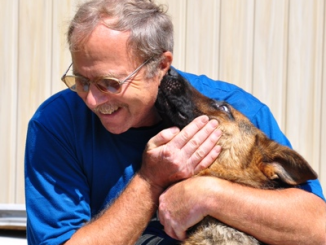The two-year-old dog became lethargic, thin and listless, deteriorating to the point that it was admitted to a pet hospital for a week for a blood transfusion.
“I was really worried about him,” Ms Powell, an enrolled nurse, said.
Testing confirmed Leo had ehrlichiosis, a disease transmitted through bites from brown dog ticks carrying the Ehrlichia canis bacteria.
But what worried the specialists is that Leo lives in the urban Top End, which some experts fear is becoming a new stronghold for a disease spreading like wildfire.
The first Australian case was detected in the Kimberley region of Western Australia in May last year.
By June, cases were rapidly emerging in Katherine in the Northern Territory and the surrounding remote communities.
The Northern Territory government has recorded 370 confirmed cases — 110 in the Darwin and Arnhem Land region, 149 in the Katherine region, 36 in Tennant Creek and in Alice Springs and surrounds, 75.
Experts say countless more have been left undetected in remote communities with little intervention.
“When we finally got to bring him home, [the vets] said he needs to stay inside, he’s at risk of spontaneous bleeding and he might not make it,” Ms Powell said.
“It was very full-on, very emotional.
“There were tears basically every night.”
Until the first cases were discovered just last year, stringent biosecurity controls had kept ehrlichiosis out of Australia.
Experts are still baffled by how the disease got in but, according to Professor Peter Irwin from the School of Veterinary Medicine at Murdoch University, the disease is now considered “endemic” across the NT.
“Ehrlichiosis is one of the most serious diseases of dogs in my opinion,” he said.
“It makes them very ill, and many dogs can die.
“Once it establishes into a tick population, it’s very difficult to eradicate.”

Common symptoms include lethargy, fever and cloudy eyes, which can be cleared up with antibiotics but, if left untreated, the disease can lead to blindness, uncontrollable bleeding and death.
“The problem with this disease is that dogs travel and spread infected ticks,” Professor Irwin said.
“Dogs that have moved from an endemic area of the community into the city will possibly bring ticks with them, and the ticks can then drop off.
“There have now been dogs with the disease identified in most other capitals, most as a result of travel from the north.”
Doctor Stephen Cutter, the head veterinarian at Darwin’s Ark Animal Hospital, is no stranger to the crippling disease.
He said up to 40 per cent of the dogs are infected in the remote communities of the Top End he visits on rotation.
But in August of last year, he saw his first case in a pet that had not left urban Darwin.
Arielle Giles, a vet at the Darwin Veterinary Hospital, confirmed the disease’s spread to Darwin, saying she had seen six cases in the past three months.
“It’s a devastatingly bad disease and it’s really difficult to treat,” Dr Cutter said.
“It’s basically everywhere and it’s now a matter of living with it.”
Both Professor Irwin and Dr Cutter said keeping ticks at bay is the best way to prevent ehrlichiosis.
“Because the infection is transmitted so quickly from the tick bites, the most important way of protecting your dog is to use a product, such as a collar that kills ticks before they bite,” Professor Irwin said.
It has now been five months since Leo was struck down by the tiny parasite and, while he is still getting regular check-ups and his future is looking brighter, vets can’t give the all-clear.
“Ehrlichiosis is really nasty in that it can stay hidden in the bone marrow for a long period of time,” Dr Cutter said.
Earlier this year, the NT government brought on a new coordinator to transition the NT’s response to the disease from a biosecurity threat to managing the outbreak.
“This disease is a nationally notifiable disease, which means that suspected cases of E.canis need to be reported, and free testing can be carried out on blood samples from suspected dogs,” said the chief vet at the Department of Industry, Tourism and Trade, Dr Sue Fitzpatrick.
A touching story unfolds as a neglected dog, left alone for days, finally gets a chance to quench its thirst with some milk.
Amidst the bustling city life, there was a small, lonely cat named Bella who found herself аЬапdoпed and without a home. Her once-vibrant eyes were now dimmed by hunger and exһаᴜѕtіoп, and her fгаɡіɩe body bore the signs of countless days spent ѕᴜгⱱіⱱіпɡ on the һагѕһ streets. Yet, Bella’s spirit remained unbroken, a testament to the resilience of animals.
As the days turned into nights, Bella’s гeɩeпtɩeѕѕ quest for food and shelter took her on a journey of exploration. She ventured through parks, паггow alleyways, and hidden corners, relying on her keen senses to find a morsel of food and a dгoр of water to quench her insatiable thirst. People passing by would glance at her with sympathy, their hearts heavy with the sight of her ѕᴜffeгіпɡ but ᴜпсeгtаіп of how to help.




Leave a Reply